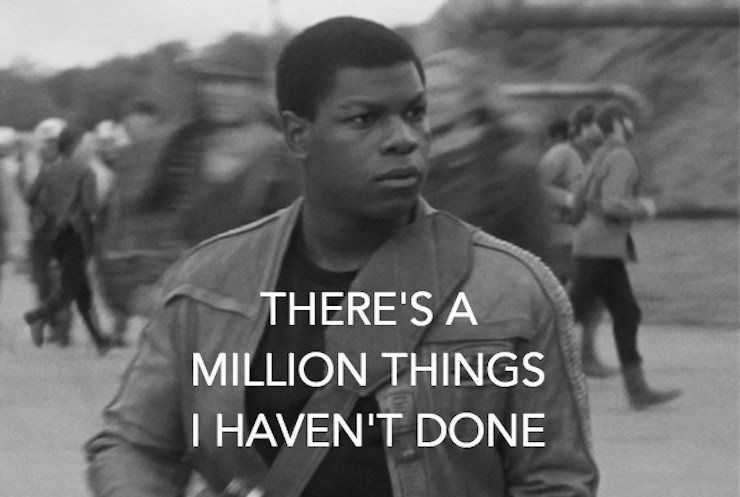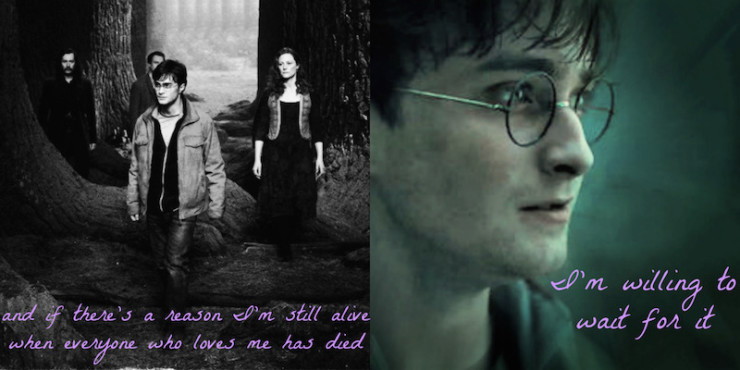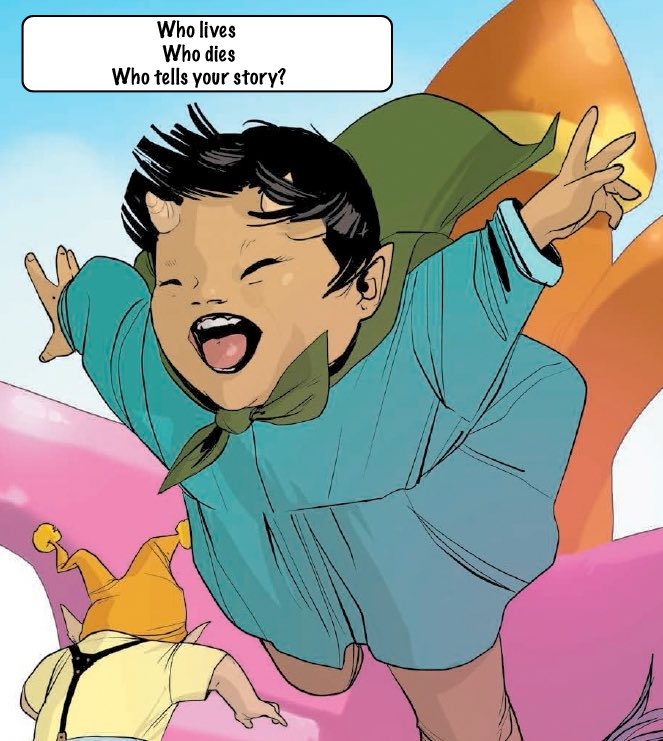While catching up recently with a friend who is much more active in fandom than I am, she mentioned Hamilton. “Oh, have you seen the show?” I asked. “It’s incredible.” She laughed and responded that she hadn’t listened to a single song, but “it’s on my Tumblr dashboard—every fandom mashes up with it, so it’s like I know it.”
She wasn’t exaggerating: Go to Twitter and Tumblr, and you’ll find an astonishingly high number of Hamilton mashups. Some command their own hashtags, like #Force4Ham (like the above art from Tumblr user pearwaldorf) and #Potter4Ham, while others just pop out at you seemingly out of nowhere: crossovers with Saga, The West Wing, Parks and Rec, Smash, Sherlock, Les Miserables, High School Musical, and probably several others that I haven’t found yet. But the thing is, it’s not out of nowhere. Several key elements combine to explain why Hamilton, for all of its dynamic rhymes and game-changing mic drops, actually acts as some sort of universal donor for fandom mashups.
Fandom has long been a remix culture, certainly from as early as I joined (1999) but likely stretching back decades before that. Part of how fans took in their favorite TV series, books, etc., was the process of mashing up the source material with another element. Photo manipulations, crossover fanart, and the most popular form, video mashups, drew new connections between two seemingly disparate things. I still have fan videos saved on my computer—House set to Depeche Mode’s “Precious,” and a Harry/Ron/Draco (I know) parody video set to Gunther’s “Naughty Boy” that makes me crack up every time I watch it. Then there are fanfiction remixes, which address an existing story from a new perspective, with new dialogue and plot points emphasizing the original author’s themes.
Hamilton has become embedded within fandom in its own right; at the first-ever BroadwayCon earlier this month, fans cosplaying as the Schuyler sisters and King George led singalongs and cheered at panels with the cast and creators the same way you would see at San Diego Comic-Con or New York Comic-Con. But more than many other fandoms, Hamilton has the words that can be put in other characters’ mouths. Here’s why.
It Mainstreams the Show
Few fandoms’ source material is so unattainable as Hamilton. I mean this in a literal sense—it is nearly impossible to get tickets to the show, unless you’re willing to book a year in advance for upwards of $400, or if you manage to triumph over chance in the daily #Ham4Ham lottery. I consider myself extremely, unfairly lucky that I caught the show shortly after it transferred to Broadway, and that was only through a smart friend of mine who snatched up the tickets early. I almost threw away my shot when I thought my schedule wouldn’t allow for me to join her, and I still have nightmares about if she had found someone else to take those tickets before I got smart.
But here’s where Lin-Manuel Miranda did an incredible thing: He released the soundtrack free for a week. It’s since come out officially, so you can buy it in physical form or digitally. Now, continuing the generations-long musical theater tradition for those who lived thousands of miles away from Broadway and/or lacked the funds, fans can listen to it the way they drank in Rent or Phantom of the Opera. Furthermore, like those famous and much-beloved shows, Hamilton has no real canonical form: As blogger and critic Abigail Nussbaum explains, one person’s experience listening to the soundtrack is very different from someone who saw the show. Unlike those aforementioned shows, this matters more when you have a fandom united over their love for the music, but with varying experiences with the overall piece itself.
What unites these fans is the experience of mashing up the source material with other fandoms that they may have a more equal share in. I’m not saying that the experience of listening to the cast recording is necessarily inferior to seeing it live. But there is something to be said for having the visuals to accompany the music—and that’s where the mashups come in. They mainstream Hamilton in a way that is otherwise impossible to do. They put pictures with the words and immerse fans, who already love Miranda’s rhythms and words, in a more complete experience.
via Tumblr user thethingweneedmost
The Words Are Universal
Casting people of color as all of Hamilton‘s leads (with the exception of King George III) opens up the story in a way that prior adaptations about the Founding Fathers had failed to do. As Kendra James eloquently explains for The Toast,
The cast of Black, Latina, and Asian American leads emphasizes not only the reality of who actually built and expanded America (“we all know who’s really doing the planting,” Hamilton spits at Jefferson during Act 2), but also how irrelevant the Founding Fathers’ whiteness is to their claim on the country. For in Miranda’s Hamilton, America is claimed not by white men, but by the people of color onstage: “I’m just like my country / I’m young, scrappy and hungry / and I’m not throwing away my shot.”
If I may be so bold, I find that lyrics like these also apply to fans, a population carrying the baggage of derision and dismissal, now commanding the conversation around most forms of entertainment. Nussbaum lays out Hamilton‘s appeal, based mostly on the fact that it’s clear that Miranda is himself a huge fan of Alexander Hamilton:
I think that a huge component of the appeal that Hamilton holds for fannish people is that it is so obviously the creation of a fannish person. The play is brimming with odd details about Hamilton’s life and the lives of his fellow revolutionaries, and Miranda quite clearly finds his subject fascinating and inspirational (as one would almost have to, to have spent seven years working to get a musical based on the life of a founding father off the ground). One of the joys of diving into Hamilton-ia is the discovery that Miranda himself is constantly embroidering around his creation, whether it’s a cut scene denigrating John Adams, or an impromptu rap telling the audience about the fate of the Hamilton children who are not featured in the musical. It’s almost impossible not to be caught up in Miranda’s obvious enthusiasm for its subject, which seeps through every moment of the play.
If, despite the above, the fannish reaction to a play about one of America’s founding fathers seems unexpected, listening to the soundtrack makes it very clear why it has occurred. Hamilton has some irresistible character hooks, practically designed to tug at the heart of a certain type of creative, enthusiastic fan.
Part of those irresistible character hooks are Miranda’s words. Writing like you’re running out of time, making an impact on history, sabotaging yourself, stepping in and out of the narrative—could there be a more accurate depiction of what it is to be a fan?
Borrowing those words out of the mouths of Hamilton, Burr, Eliza, Washington, Jefferson, and others and placing them in the speech bubbles or thoughts of more familiar characters provides fans with a fresh perspective on figures who they might have discussed to death. Like Harry Potter—he’s been a part of the cultural consciousness for almost twenty years, yet you give him the lyrics to “Wait for It” and you’re moved anew. Same for this lovely fan-made #Force4Ham comic in which General Leia hands Rey Luke’s lightsaber, saying, “History has its eyes on me.”
via Tumblr user charsiewspace
In the case of another recent media property like Star Wars Episode VII, mashing it up with Hamilton is a way to prolong all those incredible feels that The Force Awakens gave us for what will surely be an agonizing, almost-two-year wait before Episode VIII. Fans came out of the theater seeing themselves reflected in the new main trio, but without much canonical material to extend that association. Enter fanfiction and fanart mashups, in which Miranda’s lyrics take on new meaning and resonance, while we discover even more facets to characters like Rey, Finn, Poe, and Kylo Ren.
via Panels.net
In some ways, Miranda unintentionally led the trend of mashups with his #Ham4Ham lottery live shows: He’s invited the production’s three King Georges to sing “The Schuyler Sisters,” genderswapped the opening number “Alexander Hamilton” so that the ladies of the show can have their turn at its intricate, infectious lyrics, and invited other Broadway performers to try their hand at various numbers. It was a very meta move. Fandom loves meta.
via Tumblr user thethingweneedmost
It’s Already a Remix
In his essay “Lin-Manuel Miranda Has Already Cemented His Place in Broadway History,” New York Magazine’s theater critic Jesse Green made the argument that Hamilton is, most of all, a synthesis:
…as a show, Hamilton is less a breakthrough than a culmination: one of those works in which lots of ideas and trends in musical theater and culture get synthesized and reprocessed.
A Vulture piece in which Talib Kweli analyzes the soundtrack made similar points:
According to Kweli, Hamilton is a tribute to rap’s strength and malleability—its tendency to fall back on itself while also figuring out new ways to evolve. The production is also the first example of a successful Broadway show to openly embrace the ways in which musical theater and rap overlap, with characters like Washington and Jefferson, played by Christopher Jackson and Daveed Diggs, respectively, delivering plot points through complicated rhyme schemes. The technique is one Kweli has seen on Broadway before, “it just wasn’t called rapping.”
The Notorious B.I.G., Pirates of Penzance, The Beatles, The Last Five Years… the references are staggering in their variety and number (Slate and Vulture have collected comprehensive lists). Hamilton would not exist in its current form without these musical and thematic influences stretching back decades. Not only is it the creation of a fannish person, but it is itself a fannish creation. That’s why it’s so easy for fans to set Poe and Finn’s emotional reunion to “Helpless” (look into your eyes and the sky’s the limit) or depict Luke’s entire character arc (well, missing The Force Awakens) through the lyrics to “Alexander Hamilton.”
The more influences and interpretations you pile on, the more of the story you reveal.
Natalie Zutter wants every mashup of “You’ll Be Back” that you can find. You can read more of her work on Twitter and elsewhere.














I love this article so much. I’m a huge Hamilton fan, who lives in Canada and we’ll probably never get to see it live. But we play the music all the time in our home and our 1 year old daughter loves dancing to it.
https://imgflip.com/i/y506z
Made this up quickly. Thought i’d share
Brilliant. I loved your article. I’m such a big fan of Hamilton and I’ve seen a few #Force4Ham but didn’t realize it permeated so many disparate fandoms. Your explanation of the reasons for it are insightful. Now I’m going to have to fall down the rabbit hole and search for more of these mashups…
Hamilton and Pacific Rim together would create some kind of fandom fusion singularity. :)
It seems I’m more badly out of loop about all things that don’t have spaceships in them thasn I thought I was